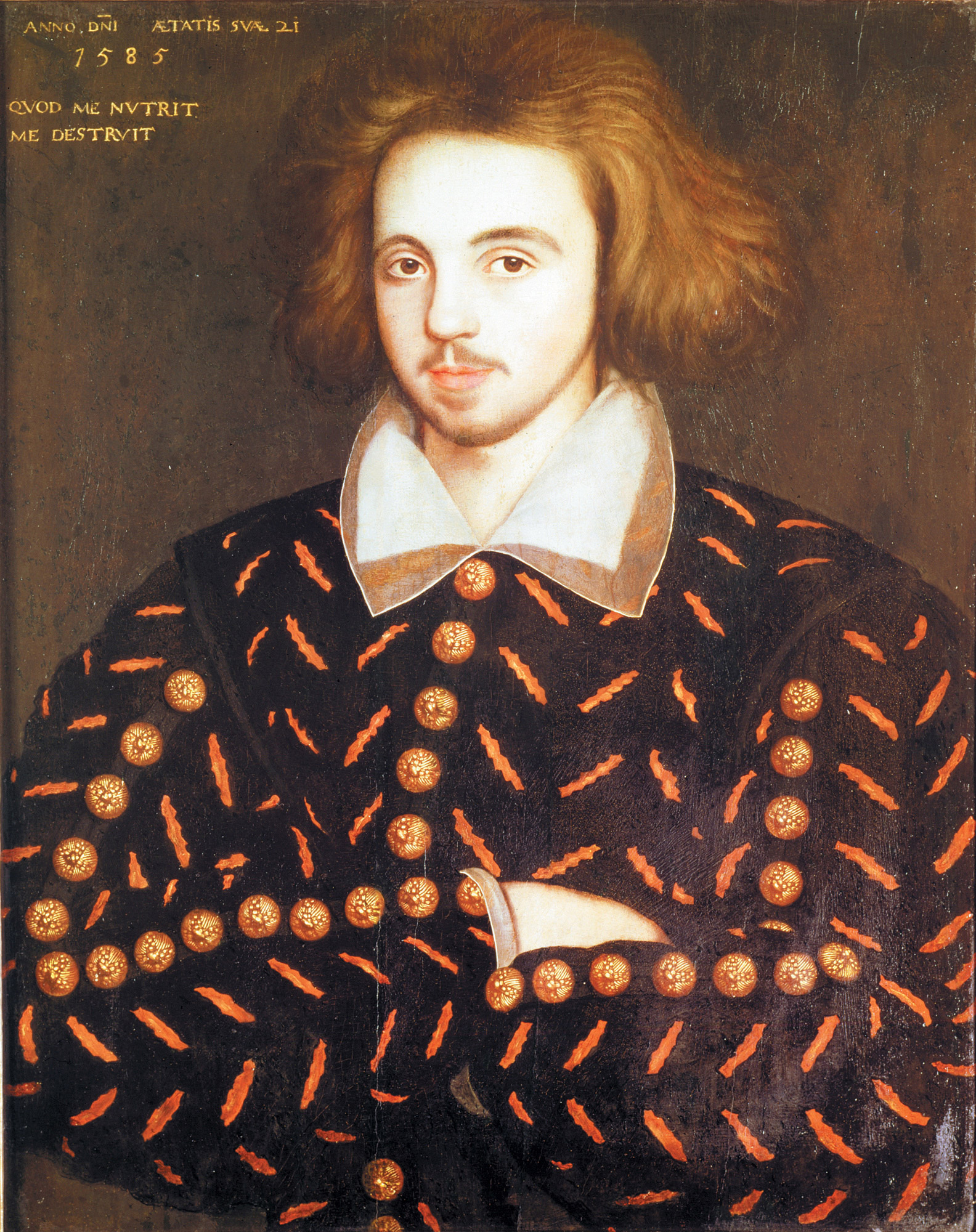
Christopher Marlowe (Christened 1564 – Died 30 May 1593), known to friends by his nickname Kit, was an English playwright and poet who lived a short life ridden with scandal and brilliance. Marlowe was the eldest son of a local cobbler in Canterbury named John Marlowe (see Family Tree). Though his birth is not documented, his baptism in Canterbury was recorded on February 26 1564, just a few months prior to fellow playwright William Shakespeare.
Marlowe’s earliest known education was in 1578 when he earned a position at King’s School in Canterbury. Here, Marlowe became well-versed in Latin classics. In 1580, Marlowe received a scholarship from the former Archbishop of Canterbury, Matthew Parker, to study at Corpus Christi College in Cambridge. This scholarship was offered to those that showed potential in rhetoric and dialect. “Marlowe had to master that language’s complex rules of versification. Classical Latin poetry is metrical, not rhymed: the lines of Virgil’s Aeneid or Ovid’s Metamorphoses are structured not by a rhyme-scheme, but by the need to conform to set patterns of long and short vowel sounds” (Rutter 3).

Blank verse is any line that doesn’t rhyme in the same meter, usually in iambic pentameter. This brought a sort of liveliness in Marlowe’s playwriting that Ben Jonson would later call “Marlowe’s mighty line” in his elegy for Shakespeare.
At Cambridge, Marlowe would study the classical trivium, grammar, dialectic, and rhetoric, as well as philosophy; all course work was conducted in Latin. Students demonstrated their learning in public debates with peers, some of whom may have been Thomas Nashe and Robert Greene, who were then at St. John’s College. It is also likely that Marlowe translated Ovid’s The Amores (first written c. 16 B.C.) at Cambridge, and he and Nashe may also have collaborated on Dido, Queen of Carthage.
Marlowe’s time at Cambridge was notoriously full of gaps, and he nearly didn’t graduate. Many believe these absences support arguments that Marlowe was a spy working for the Elizabethan government. It is believed that during his time at university, Marlowe would have observed his peers for any signs of heresy against the church.
In 1587, authorities at the university attempted to deny Marlowe of his MA due to him not completing his coursework. Officials from the Privy council overruled the decision, suggesting that he had helped the queen herself – another reason why some believe Marlowe to be a spy (See also: Marlowe & Espionage).
Marlowe dealt with constant legal trouble during his life. In 1588, he was sued by James Wheatly for a dispute over a horse, and his Cambridge peer Edward Elwyn sued him for failing to pay back a loan (Mateer). Marlowe also had a reputation for violence. In 1589, Marlowe and fellow poet, Thomas Watson, got into a sword-fight with William Bradley in Hog Lane. Bradley was stabbed to death, by whom is not certain, and both were subsequently jailed at Newgate Prison. Marlowe was released on bail twelve days later, but Watson served for months (accused of manslaughter, released Feb 1590).
Whether he was working for the Anglicans, the Catholics, or both, Marlowe was reputedly skeptical about religion. His first big hit, Tamburlaine, was hardly a celebration of Christian values.
The first known mention of the play Tamburlaine the Great (1587) was in a letter dating 1587, although it was referencing the second part of the play, was apparently written within the same year. While a definitive date for the first showing is unknown, the timeline suggests that Marlowe may have written some of this play while at university.
The play was a massive success and set the foundation for the early modern stage. Throughout the play, signs of Marlowe’s atheism become more apparent as he creates a character that seems to take on God himself. Tamburlaine’s character is one that defies fate and creates his own destiny.
Throughout his short life, Marlowe also wrote Dido Queen of Carthage, Tamburlaine the Great, Part 2, Massacre of Paris, The Tragical History of Doctor Faustus, The Troublesome Raigne and Lamentable Death of Edward the Second, and The Jew of Malta.
Since the 18th Century, readers of English playwrights have speculated that Marlowe helped William Shakespeare with the conception of King Henry VI. The two playwrights would have been popular around the same time,1590-93, and both of their plays were even shown at the public theater, The Rose. The two were also way ahead of other playwrights at the time in terms of their grasp of blank verse. Recent stylometric studies have confirmed that Marlowe and Shakespeare both contributed to several of these plays, and offer evidence for the collaborative nature of playmaking in early modern London (see “Authorship, DRAFT”).
In the Spring of 1593, a xenophobic poem ordering protestants to leave England was posted on Churchyards around London, and signed “Tamburlaine.” The Privy Council were upset at the libel being spread across the city. While his involvement was unclear, the religious tension Marlowe’s plays created prompted the Privy council to get involved. Marlowe’s flatmate and fellow dramatist Thomas Kyd was allegedly tortured in order to get a confession that Marlowe was an atheist. This led to a warrant being put out for Marlowe’s arrest.
On May 30th, 1593, Marlowe was stabbed to death at Eleanor Bull’s rooming house in Deptford. Was he stabbed by a fellow spy? Was it an argument over the bill, or “reckoning”? The mystery remains.
